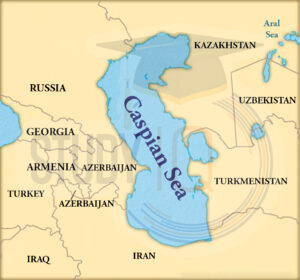Table of Contents
Caspian Sea
The Caspian Sea is divided into three areas: northern, middle, and southern, based on underwater features and water characteristics. It has about 50 islands, mostly small. The largest islands include Chechen, Tyuleny, Morskoy, Kulaly, Zhiloy, and Ogurchin.
- The Caspian Sea is the world’s largest inland body of water located between the Caucasus Mountains and Central Asia.
- Its name comes from the ancient Kaspi people who lived nearby.
- The sea stretches about 1200 km long and has an average width of 320 km.
- It covers around 386400 square km larger than Japan, and is 27 meters below sea level.
- The maximum depth is 1025 meters in the south.
- The Caspian is bordered by Kazakhstan, Turkmenistan, Iran, Azerbaijan, and Russia.
- It is the largest salt lake in the world, though it was once connected to the ocean millions of years ago.
- The Caspian Sea supports fishing, shipping, and oil and gas production, and its sandy beaches are popular for recreation.
Read More: Mediterranean Sea
Caspian Sea Bordering Countries
The Caspian Sea is surrounded by five countries:
- Russia,
- Kazakhstan,
- Turkmenistan,
- Iran, and
- Azerbaijan.
Read More: Sea of Azov
Caspian Sea in World Map
Here is the Map of the Caspian Sea including neighbouring countries with international borders.

Read More: South China Sea
Caspian Sea Geographical Features
East of the Caucasus, west of the wide steppe of Central Asia, south of the rich plains of Southern Russia in Eastern Europe, and north of the high Iranian Plateau in Western Asia, the Caspian Sea is located between Europe and Asia. The Caspian Sea, which makes up 40 to 44% of all lacustrine waters on the planet, is the biggest inland body of water. There are several islands in the Caspian Sea, however, they are all located close to the coast and none are found in the deeper waters. Island Ogurja Ada is the biggest.
Read More: East China Sea
Caspian Sea Environmental Concerns
More than 80% of the water that flows into the Caspian Sea comes from the Volga River. However, the lower part of the Volga is polluted with chemicals and other harmful substances because of many factories in the area.
The Caspian Seas face the weight of several wastes that are predominantly introduced into its basin by the Volga River, the United Nations Environment Programme says. Numerous islands, including Vulf, have experienced ecological harm as a result of the region’s substantial oil drilling. As a result, the populations of numerous avian and marine species have been greatly reduced.
Read about: Pacific Ocean
Caspian Sea Important Facts for UPSC
- The Caspian Sea, which has an area of around 371000 square kilometers, is the biggest inland body of water in the world. The Sea has surpassed other inland water bodies as the largest one with few outflow zones.
- The seafloor is Earth’s second-lowest natural relief depression and is an endorheic basin with no natural outlets.
- The Caspian Sea, an inland lake, hosts several local marine plant and animal species, most of which are protected.
- Species specific to the Caspian Sea often have “Caspian” in their names, like the Caspian seal, Caspian tern, Caspian gull, and Caspian turtle.
- Neighboring nations rely heavily on the Caspian Sea’s mineral resources, such as oil and gas, which make up about 40% of exports and 10% of GDP.
- The Caspian Depression is one of the lowest spots on Earth, located in the northern part of the Caspian Sea.
- The Caspian Sea is considered either the world’s largest lake or a true sea.
- The Volga River is the main tributary, providing about 80% of the inflowing water, with other significant tributaries being the Kura and Ural rivers.
- Unlike most bodies of water, the Caspian Sea has never been correctly classified into one of the six major categories: oceans, seas, lakes, rivers, streams, and pools.
Read More: Atlantic Ocean
Is the Caspian Sea a Lake?
Since it was first discovered a long time ago people have called the Caspian Sea a sea. The nearby countries Azerbaijan, Iran, Kazakhstan, Russia, and Turkmenistan also call it a sea in their own languages.
But the Caspian Sea has several distinctive qualities that make determining its identity difficult. It is an inland sea that can only be reached by way of the canals that connect Russia’s Volga River to the Black Sea, the Baltic Sea, and the Sea of Azov. It receives its water from freshwater sources and is not connected to the world’s open oceans via saltwater. The conclusions of the United Nations Group of Experts on Geographical Names are not binding in court.
Read More: Ocean Waves


 Story of Meera Bai and Her Devotion For ...
Story of Meera Bai and Her Devotion For ...
 Desert Climate, Distribution, Climatic C...
Desert Climate, Distribution, Climatic C...
 Deserts of India Map, Features of Thar D...
Deserts of India Map, Features of Thar D...





















